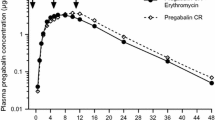Summary
The bioavailability of theophylline after oral administration of a new sustained release tablet Theograd®-250 mg was studied in 7 healthy volunteers, under fasting and non-fasting conditions. Whilst fasting the bioavailability was moderate at 64±22% (mean±SD), whereas in the non-fasting state the relatively high bioavailability of 90±13% was found. The drug appeared to be significantly more slowly absorbed when a tablet was taken after a meal, than when it was ingested on an empty stomach. In the former case, the peak level was reached after 6.9±1.0 h, whereas in the fasting state the maximum serum concentration occurred 4.0±1.7 h after administration of the drug. Despite the slow absorption, the peak non-fasting level of 4.4±1.4 mg·l−1 was significantly higher than the 3.1±1.0 mg·l−1 observed in the fasting state. The profiles of the serum concentration-time curves showed that the concentration remained above 75% of Cmax for 8.7±1.3 h in the fasting and 9.0±1.1 h in the non-fasting state. It was concluded that to define the optimal dosage regime for sustained release oral dosage forms of theophylline, the influence of food on absorption from these preparations should be taken into account. Based on the present results, Theograd®-250 mg tablets have predictable absorption and a high (90%) bioavailability if taken after a meal.
Similar content being viewed by others
References
Bogentoft C, Sjögren J (1980) Controlled release from dosage forms. In: Breimer DD (ed) Towards better safety of drugs and pharmaceutical products. Elsevier/Holland, Amsterdam, pp 229–246
Higuchi T (1963) Mechanism of sustained-action medication-theoretical analyses of rate of release of solid drugs dispersed in solid matrices. J Pharm Sci 52: 1145–1149
Jenne JW, Wyze E, Rood FS, MacDonald FM (1972) Pharmacokinetics of theophylline, application to adjustment of the clinical dose of aminophylline. Clin Pharmacol Ther 13: 349–360
Jonkman JHG, Schoenmaker R, Greving JE, de Zeeuw RA (1980a) Rapid selective theophylline serum and saliva assay by means of high pressure liquid chromatography. Pharm Week-blad (Sci Ed) 2: 49–53
Jonkman JHG, Berg WChr, Schoenmaker R, de Zeeuw RA, Greving JE, Orie NGM (1980b) Disposition and clinical pharmacokinetics of microcrystalline theophylline. Eur J Clin Pharmacol 17: 379–384
Jonkman JHG, Schoenmaker R, Grimberg N, de Zeeuw RA (1981) A new in vitro dissolution test for controlled-release theophylline tablets. Int J Pharm 8: 153–156
Lesko LJ, Canada AT, Eastwood G, Walker D, Brousseau DR (1979) Pharmacokinetics and relative bioavailability of oral theophylline capsules. J Pharm Sci 68: 1392–1394
Levy G, Koysooko R (1975) Pharmacokinetic analysis of the effect of theophylline on pulmonary function in asthmatic children. J Pediatr 86: 789–793
Mellstrand T, Svedmyr N, Fagerström PO (1980) Absorption of theophylline from conventional and sustained-release tablets. Eur J Respir Dis 61 [Suppl 109]: 54–61
Mitenko PA, Ogilvie RI (1973) Rational intravenous doses of theophylline. N Engl J Med 289: 600–603
Mitenko PA, Ogilvie RI (1974) Bioavailability and efficacy of a sustained-release theophylline tablet. Clin Pharmacol Ther 16: 720–726
Ogilvie RI (1978) Clinical pharmacokinetics of theophylline. Clin Pharmacokinet 3: 267–293
Pedersen S (1981) Delay in the absorption rate of theophylline from a sustained release theophylline preparation caused by food. Br J Clin Pharmacol 12: 904–905
Ritschel WA (1980) Handbook of basic pharmacokinetics (2nd ed) Drug Intelligence, Hamilton, Ill, USA
Sharma JN, Johnstrom A, Blackett A, Hathway NR (1981) A single-dose comparison of four slow-release theophylline preparations in normal subjects. Postgrad Med J 57: 153–155
Upton RA, Thiercelin JF, Guentert TW, Samson L, Powell JR, Coates PE, Riegelman S (1980a) Evaluation of the absorption from some commercial sustained-release theophylline products. J Pharmacokinet Biopharm 8: 131–149
Upton RA, Samson L, Guentert TW, Powell JR, Thiercelin JF, Coates PE, Riegelman S (1980b) Evaluation of the absorption from 15 commercial immediate-release theophylline products. J Pharmacokinet Biopharm 8: 229–242
Wagner JG, Nelson E (1963) Per cent absorbed time plots derived from blood level and/or urinary excretion data. J Pharm Sci 52: 610–611
Walson PD, Strong RC, Taussig LM (1977) Intrapatient variability in the theophylline kinetics. J Pediatr 91: 321–324
Weinberger M, Bronsky EA (1974) Evaluation of oral bronchodilator therapy in asthmatic children. J Pediatr 84: 421–427
Weinberger M, Hendeles L, Bighley L (1978) The relation of product fromulation to absorption of oral theophylline. N Engl J Med 299: 852–857
Welling PG, Lyons LL, Craig WA, Trochta GA (1975) Influence of diet and fluid on bioavailability of theophylline. Clin Pharmacol Ther 17: 475–480
Author information
Authors and Affiliations
Rights and permissions
About this article
Cite this article
Lagas, M., Jonkman, J.H.G. Greatly enhanced bioavailability of theophylline on postprandial administration of a sustained release tablet. Eur J Clin Pharmacol 24, 761–767 (1983). https://doi.org/10.1007/BF00607084
Received:
Accepted:
Issue Date:
DOI: https://doi.org/10.1007/BF00607084




